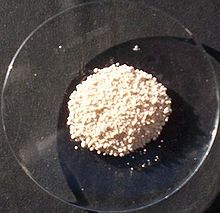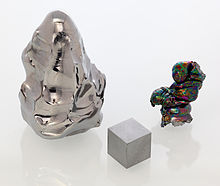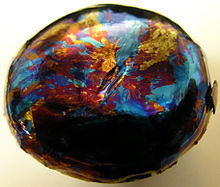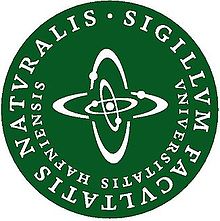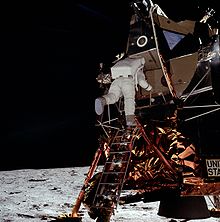- Hafnium
-
lutetium ← hafnium → tantalum Zr
↑
Hf
↓
RfAppearance steel gray

General properties Name, symbol, number hafnium, Hf, 72 Pronunciation /ˈhæfniəm/
haf-nee-əmElement category transition metal Group, period, block 4, 6, d Standard atomic weight 178.49 Electron configuration [Xe] 4f14 5d2 6s2 Electrons per shell 2, 8, 18, 32, 10, 2 (Image) Physical properties Phase solid Density (near r.t.) 13.31 g·cm−3 Liquid density at m.p. 12 g·cm−3 Melting point 2506 K, 2233 °C, 4051 °F Boiling point 4876 K, 4603 °C, 8317 °F Heat of fusion 27.2 kJ·mol−1 Heat of vaporization 571 kJ·mol−1 Molar heat capacity 25.73 J·mol−1·K−1 Vapor pressure P (Pa) 1 10 100 1 k 10 k 100 k at T (K) 2689 2954 3277 3679 4194 4876 Atomic properties Oxidation states 4, 3, 2 (amphoteric oxide) Electronegativity 1.3 (Pauling scale) Ionization energies 1st: 658.5 kJ·mol−1 2nd: 1440 kJ·mol−1 3rd: 2250 kJ·mol−1 Atomic radius 159 pm Covalent radius 175±10 pm Miscellanea Crystal structure hexagonal Magnetic ordering paramagnetic[1] Electrical resistivity (20 °C) 331 nΩ·m Thermal conductivity 23.0 W·m−1·K−1 Thermal expansion (25 °C) 5.9 µm·m−1·K−1 Speed of sound (thin rod) (20 °C) 3010 m·s−1 Young's modulus 78 GPa Shear modulus 30 GPa Bulk modulus 110 GPa Poisson ratio 0.37 Mohs hardness 5.5 Vickers hardness 1760 MPa Brinell hardness 1700 MPa CAS registry number 7440-58-6 Most stable isotopes Main article: Isotopes of hafnium iso NA half-life DM DE (MeV) DP 172Hf syn 1.87 y ε 0.350 172Lu 174Hf 0.162% 2×1015 y α 2.495 170Yb 176Hf 5.206% 176Hf is stable with 104 neutrons 177Hf 18.606% 177Hf is stable with 105 neutrons 178Hf 27.297% 178Hf is stable with 106 neutrons 178m2Hf syn 31 y IT 2.446 178Hf 179Hf 13.629% 179Hf is stable with 107 neutrons 180Hf 35.1% 180Hf is stable with 108 neutrons 182Hf syn 9×106 y β− 0.373 182Ta haf-nee-əm) is a chemical element with the symbol Hf and atomic number 72. A lustrous, silvery gray, tetravalent transition metal, hafnium chemically resembles zirconium and is found in zirconium minerals. Its existence was predicted by Dmitri Mendeleev in 1869. Hafnium was the penultimate stable isotope element to be discovered (rhenium was identified two years later). Hafnium is named for Hafnia, the Latin name for "Copenhagen", where it was discovered. Hafnium is used in filaments and electrodes. Some semiconductor fabrication processes use its oxide for integrated circuits at 45 nm and smaller feature lengths. Some superalloys used for special applications contain hafnium in combination with niobium, titanium, or tungsten.
Hafnium's large neutron capture cross-section makes it a good material for neutron absorption in control rods in nuclear power plants, but at the same time requires that it be removed from the neutron-transparent corrosion-resistant zirconium alloys used in nuclear reactors.
Contents
Characteristics
Physical characteristics
Hafnium is a shiny, silvery, ductile metal that is corrosion-resistant and chemically similar to zirconium[2] (due to its having the same number of valence electrons and being in the same group). The physical properties of hafnium metal samples are markedly affected by zirconium impurities, especially the nuclear properties, as these two elements are among the most difficult to separate because of their chemical similarity.[2]
A notable physical difference between these metals is their density, with zirconium having about one-half the density of hafnium. The most notable nuclear properties of hafnium are its high thermal neutron-capture cross-section and that the nuclei of several different hafnium isotopes readily absorb two or more neutrons apiece.[2] In contrast with this, zirconium is practically transparent to thermal neutrons, and it is commonly used for the metal components of nuclear reactors – especially the claddings of their nuclear fuel rods.
Chemical characteristics
See also Category: Hafnium compounds.Hafnium reacts in air to form a protective film that inhibits further corrosion. The metal is not readily attacked by acids but can be oxidized with halogens or it can be burnt in air. Like its sister metal zirconium, finely divided hafnium can ignite spontaneously in air—similar to that obtained in Dragon's Breath.[3] The metal is resistant to concentrated alkalis.
The chemistry of hafnium and zirconium is so similar that the two cannot be separated on the basis of differing chemical reactions. The melting points and boiling points of the compounds and the solubility in solvents are the major differences in the chemistry of these twin elements.[4]
Isotopes
At least 34 isotopes of hafnium have been observed, ranging in mass number from 153 to 186.[5][6] The five stable isotopes are in the range of 176 to 180. The radioactive isotopes' half-lives range from only 400 ms for 153Hf,[6] to 2.0 petayears (1015 years) for the most stable one, 174Hf.[5]
The nuclear isomer 178m2Hf was at the center of a controversy for several years regarding its potential use as a weapon.
Occurrence
Hafnium is estimated to make up about 5.8 ppm of the Earth's upper crust by weight. It does not exist as a free element in nature, but is found combined in solid solution for zirconium in natural zirconium compounds such as zircon, ZrSiO4, which usually has about 1 – 4 % of the Zr replaced by Hf. Rarely, the Hf/Zr ratio increases during crystallization to give the isostructural mineral 'hafnon' (Hf,Zr)SiO4, with atomic Hf > Zr.[7] An old (obsolete) name for a variety of zircon containing unusually high Hf content is alvite.[8]
A major source of zircon (and hence hafnium) ores are heavy mineral sands ore deposits, pegmatites particularly in Brazil and Malawi, and carbonatite intrusions particularly the Crown Polymetallic Deposit at Mount Weld, Western Australia. A potential source of hafnium is trachyte tuffs containing rare zircon-hafnium silicates eudialyte or armstrongite, at Dubbo in New South Wales, Australia.[9]
Hafnium reserves are projected to last under 10 years if the world population increases and demand grows.[10]
Production
The heavy mineral sands ore deposits of the titanium ores ilmenite and rutile yield most of the mined zirconium, and therefore also most the hafnium.[11]
Zirconium is a good nuclear fuel-rod cladding metal, with the desirable properties of a very low neutron capture cross-section and good chemical stability at high temperatures. However, because of hafnium's neutron-absorbing properties, hafnium impurities in zirconium would cause it to be far less useful for nuclear-reactor applications. Thus, a nearly complete separation of zirconium and hafnium is necessary for their use in nuclear power. The production of hafnium-free zirconium is the main source for hafnium.[2]
The chemical properties of hafnium and zirconium are nearly identical, which makes the two difficult to separate.[12] The methods first used — fractional crystallization of ammonium fluoride salts[13] or the fractionated distillation of the chloride[14] — have not proven suitable for an industrial-scale production. After zirconium was chosen as material for nuclear reactor programs in the 1940s, a separation method had to be developed. Liquid-liquid extraction processes with a wide variety of solvents were developed and are still used for the production of hafnium.[15] About half of all hafnium metal manufactured is produced as a by-product of zirconium refinement. The end product of the separation is hafnium(IV) chloride.[16] The purified hafnium(IV) chloride is converted to the metal by reduction with magnesium or sodium, as in the Kroll process.[17]
-
- HfCl4 + 2 Mg (1100 °C) → 2 MgCl2 + Hf
Further purification is effected by a chemical transport reaction developed by Arkel and de Boer: In a closed vessel, hafnium reacts with iodine at temperatures of 500 °C, forming hafnium(IV) iodide; at a tungsten filament of 1700 °C the reverse reaction happens, and the iodine and hafnium are set free. The hafnium forms a solid coating at the tungsten filament, and the iodine can react with additional hafnium, resulting in a steady turn over.[4][18]
-
- Hf + 2 I2 (500 °C) → HfI4
- HfI4 (1700 °C) → Hf + 2 I2
Chemical compounds
Hafnium and zirconium form nearly identical series of chemical compounds.[19] Hafnium tends to form inorganic compounds in the oxidation state of +4. Halogens react with it to form hafnium tetrahalides.[19] At higher temperatures, hafnium reacts with oxygen, nitrogen, carbon, boron, sulfur, and silicon.[19] Due to the lanthanide contraction of the elements in the sixth period, zirconium and hafnium have nearly identical ionic radii. The ionic radius of Zr4+ is 0.79 angstrom and that of Hf4+ is 0.78 angstrom.[19]
Hafnium(IV) chloride and hafnium(IV) iodide have some applications in the production and purification of hafnium metal. They are volatile solids with polymeric structures.[4] These tetrachlorides are precursors to various organohafnium compounds such as hafnocene dichloride and tetrabenzylhafnium.
The white hafnium oxide (HfO2), with a melting point of 2812 °C and a boiling point of roughly 5100 °C, is very similar to zirconia, but slightly more basic.[4] Hafnium carbide is the most refractory binary compound known, with a melting point over 3890 °C, and hafnium nitride is the most refractory of all known metal nitrides, with a melting point of 3310 °C.[19] This has led to proposals that hafnium or its carbides might be useful as construction materials that are subjected to very high temperatures. The mixed carbide tantalum hafnium carbide (Ta4HfC5) possesses the highest melting point of any currently known compound, 4215 °C.[20]
History
In his report on The Periodic Law of the Chemical Elements, in 1869, Dmitri Mendeleev had implicitly predicted the existence of a heavier analog of titanium and zirconium. At the time of his formulation in 1871, Mendeleev believed that the elements were ordered by their atomic masses and placed lanthanum (element 57) in the spot below zirconium. The exact placement of the elements and the location of missing elements was done by determining the specific weight of the elements and comparing the chemical and physical properties.[21]
The X-ray spectroscopy done by Henry Moseley in 1914 showed a direct dependency between spectral line and effective nuclear charge. This led to the nuclear charge, or atomic number of an element, being used to ascertain its place within the periodic table. With this method, Moseley determined the number of lanthanides and showed the gaps in the atomic number sequence at numbers 43, 61, 72, and 75.[22]
The discovery of the gaps led to an extensive search for the missing elements. In 1914, several people claimed the discovery after Henry Moseley predicted the gap in the periodic table for the then-undiscovered element 72.[23] Georges Urbain asserted that he found element 72 in the rare earth elements in 1907 and published his results on celtium in 1911.[24] Neither the spectra nor the chemical behavior matched with the element found later, and therefore his claim was turned down after a long-standing controversy.[25] The controversy was partly because the chemists favored the chemical techniques which led to the discovery of celtium, while the physicists relied on the use of the new X-ray spectroscopy method that proved that the substances discovered by Urbain did not contain element 72.[25] By early 1923, several physicists and chemists such as Niels Bohr[26] and Charles R. Bury[27] suggested that element 72 should resemble zirconium and therefore was not part of the rare earth elements group. These suggestions were based on Bohr's theories of the atom, the X-ray spectroscopy of Mosley, and the chemical arguments of Friedrich Paneth.[28] [29]
Encouraged by these suggestions and by the reappearance in 1922 of Urbain's claims that element 72 was a rare earth element discovered in 1911, Dirk Coster and Georg von Hevesy were motivated to search for the new element in zirconium ores.[30] Hafnium was discovered by the two in 1923 in Copenhagen, Denmark, validating the original 1869 prediction of Mendeleev.[31][32] It was ultimately found in zircon in Norway through X-ray spectroscopy analysis.[33] The place where the discovery took place led to the element being named for the Latin name for "Copenhagen", Hafnia, the home town of Niels Bohr.[34] Today, the Faculty of Science of the University of Copenhagen uses in its seal a stylized image of the hafnium atom.[35]
Hafnium was separated from zirconium through repeated recrystallization of the double ammonium or potassium fluorides by Valdemar Thal Jantzen and von Hevesey.[13] Anton Eduard van Arkel and Jan Hendrik de Boer were the first to prepare metallic hafnium by passing hafnium tetra-iodide vapor over a heated tungsten filament in 1924.[14][18] This process for differential purification of zirconium and hafnium is still in use today.[2]
In 1923, four predicted elements were still missing from the periodic table: 43 (technetium) and 61 (promethium) are radioactive elements and are only present in trace amounts in the environment,[36] thus making elements 75 (rhenium) and 72 (hafnium) the last two unknown non-radioactive elements. Since rhenium was discovered in 1925,[37] hafnium was the next to last element with stable isotopes to be discovered.
Applications
Several details contribute to the fact that there are only a few technical uses for hafnium: First, the close similarity between hafnium and zirconium makes it possible to use zirconium for most of the applications; second, hafnium was first available as pure metal after the use in the nuclear industry for hafnium-free zirconium in the late 1950s. Furthermore, the low abundance and difficult separation techniques necessary make it a scarce commodity.[2]
Most of the hafnium produced is used in the production of control rods for nuclear reactors.[15]
Nuclear reactors
The nuclei of several hafnium isotopes can each absorb multiple neutrons. This makes hafnium a good material for use in the control rods for nuclear reactors. Its neutron-capture cross-section is about 600 times that of zirconium. (Other elements that are good neutron-absorbers for control rods are cadmium and boron.) Excellent mechanical properties and exceptional corrosion-resistance properties allow its use in the harsh environment of a pressurized water reactors.[15] The German research reactor FRM II uses hafnium as a neutron absorber.[38]
Alloys
Hafnium is used in iron, titanium, niobium, tantalum, and other metal alloys. An alloy used for liquid rocket thruster nozzles, for example the main engine of the Apollo Lunar Modules is C103, which consists of 89% niobium, 10% hafnium and 1% titanium.[39]
Small additions of hafnium increase the adherence of protective oxide scales on nickel based alloys. It improves thereby the corrosion resistance especially under cyclic temperature conditions that tend to break oxide scales by inducing thermal stresses between the bulk material and the oxide layer.[40][41][42]
Microprocessors
The electronics industry discovered that hafnium-based compound can be employed in gate insulators in the 45 nm generation of integrated circuits from Intel, IBM and others.[43][44] Hafnium oxide-based compounds are practical high-k dielectrics, allowing reduction of the gate leakage current which improves performance at such scales.[45][46]
Other uses
Due to its heat resistance and its affinity to oxygen and nitrogen, hafnium is a good scavenger for oxygen and nitrogen in gas-filled and incandescent lamps. Hafnium is also used as the electrode in plasma cutting because of its ability to shed electrons into air.[47]
The high energy content of 178m2Hf was the concern of a DARPA funded program in the US. This program determined the possibility of using a nuclear isomer of hafnium (the above mentioned 178m2Hf) to construct high yield weapons with X-ray triggering mechanisms—an application of induced gamma emission, was infeasible because of its expense. See Hafnium controversy.
See also
References
- ^ Magnetic susceptibility of the elements and inorganic compounds, in Handbook of Chemistry and Physics 81st edition, CRC press.
- ^ a b c d e f Schemel, J. H. (1977). ASTM Manual on Zirconium and Hafnium. ASTM International. pp. 1–5. ISBN 9780803105058. http://books.google.com/?id=dI_LssydVeYC.
- ^ "Occupational Safety and Health Guideline for Hafnium". U.S. Department of Labor. http://www.osha.gov/SLTC/healthguidelines/hafnium/recognition.html. Retrieved 2008-09-10.
- ^ a b c d Holleman, Arnold F.; Wiberg, Egon; Wiberg, Nils; (1985) (in German). Lehrbuch der Anorganischen Chemie (91–100 ed.). Walter de Gruyter. pp. 1056–1057. ISBN 3110075113.
- ^ a b EnvironmentalChemistry.com. "Hafnium Nuclides / Isotopes". Periodic Table of Elements. J.K. Barbalace. http://environmentalchemistry.com/yogi/periodic/Hf-pg2.html#Nuclides. Retrieved 2008-09-10.
- ^ a b Georges, Audi (2003). "The NUBASE Evaluation of Nuclear and Decay Properties". Nuclear Physics A (Atomic Mass Data Center) 729: 3. Bibcode 2003NuPhA.729....3A. doi:10.1016/j.nuclphysa.2003.11.001.
- ^ Deer, William Alexander; Howie, R.A.; Zussmann, J. (1982). The Rock-Forming Minerals, volume 1A: Orthosilicates. Longman Group Limited. pp. 418–442. ISBN 0582465265.
- ^ Lee, O. Ivan (1928). "The Mineralogy of Hafnium". Chemical Reviews 5: 17. doi:10.1021/cr60017a002.
- ^ "Dubbo Zirconia Project Fact Sheet" (PDF). Alkane Resources Limited. June 2007. http://www.alkane.com.au/projects/nsw/dubbo/DZP%20Summary%20June07.pdf. Retrieved 2008-09-10.
- ^ cite web |url=http://www.science.org.au/nova/newscientist/ns_diagrams/027ns_005image2.jpg |title = New Scientist diagram How Long Will It Last
- ^ Gambogi, Joseph. "Yearbook 2008: Zirconium and Hafnium" (pdf). United States Geological Survey. http://minerals.usgs.gov/minerals/pubs/commodity/zirconium/myb1-2007-zirco.pdf. Retrieved 2008-10-27.
- ^ Larsen, Edwin; Fernelius W., Conard; Quill, Laurence (1943). "Concentration of Hafnium. Preparation of Hafnium-Free Zirconia". Ind. Eng. Chem. Anal. Ed. 15 (8): 512. doi:10.1021/i560120a015.
- ^ a b van Arkel, A. E.; de Boer, J. H. (1924). "Die Trennung von Zirkonium und Hafnium durch Kristallisation ihrer Ammoniumdoppelfluoride (The separation of zirconium and hafnium by crystallization of the double ammonium fluorides)" (in German). Zeitschrift für anorganische und allgemeine Chemie 141: 284. doi:10.1002/zaac.19241410117.
- ^ a b van Arkel, A. E.; de Boer, J. H. (1924). "Die Trennung des Zirkoniums von anderen Metallen, einschließlich Hafnium, durch fraktionierte Distillation (The separation of zirconium and hafnium by fractionated distillation)" (in German). Zeitschrift für anorganische und allgemeine Chemie 141: 289. doi:10.1002/zaac.19241410118.
- ^ a b c Hedrick, James B.. "Hafnium" (pdf). United States Geological Survey. http://minerals.er.usgs.gov/minerals/pubs/commodity/zirconium/731798.pdf. Retrieved 2008-09-10.
- ^ Griffith, Robert F. (1952). "Zirconium and hafnium". Minerals yearbook metals and minerals (except fuels). The first production plants Bureau of Mines. pp. 1162–1171. http://digicoll.library.wisc.edu/cgi-bin/EcoNatRes/EcoNatRes-idx?type=turn&entity=EcoNatRes.MinYB1952v1.p1172&isize=M.
- ^ Gilbert, H. L.; Barr, M. M. (1955). "Preliminary Investigation of Hafnium Metal by the Kroll Process". Journal of the Electrochemical Society 102 (5): 243. doi:10.1149/1.2430037.
- ^ a b van Arkel, A. E.; de Boer, J. H. (1925). "Darstellung von reinem Titanium-, Zirkonium-, Hafnium- und Thoriummetall (Production of pure titanium, zirconium, hafnium and Thorium metal)" (in German). Zeitschrift für anorganische und allgemeine Chemie 148: 345. doi:10.1002/zaac.19251480133.
- ^ a b c d e "Los Alamos National Laboratory – Hafnium". http://periodic.lanl.gov/72.shtml. Retrieved 2008-09-10.
- ^ Deadmore, D. L. (1964). "Vaporization of Tantalum-Carbide-Hafnium-Carbide Solid Solutions at 2500 to 3000 K" (PDF). NASA. http://ntrs.nasa.gov/archive/nasa/casi.ntrs.nasa.gov/19650001401_1965001401.pdf. Retrieved 2008-11-02.
- ^ Kaji, Masanori (2002). "D. I. Mendeleev's concept of chemical elements and The Principles of Chemistry" (pdf). Bulletin for the History of chemistry 27: 4. http://www.scs.uiuc.edu/~mainzv/HIST/awards/OPA%20Papers/2005-Kaji.pdf. Retrieved 2008-08-20.
- ^ Heilbron, John L. (1966). "The Work of H. G. J. Moseley". Isis 57 (3): 336. doi:10.1086/350143.
- ^ Heimann, P. M. (1967). "Moseley and celtium: The search for a missing element". Annals of Science 23 (4): 249. doi:10.1080/00033796700203306.
- ^ Urbain, M. G. (1911). "Sur un nouvel élément qui accompagne le lutécium et le scandium dans les terres de la gadolinite: le celtium (On a new element that accompanies lutetium and scandium in gadolinite: celtium)" (in French). Comptes rendus: 141. http://gallica.bnf.fr/ark:/12148/bpt6k3105c/f141.table. Retrieved 2008-09-10.
- ^ a b Mel'nikov, V. P. (1982). "Some Details in the Prehistory of the Discovery of Element 72". Centaurus 26 (3): 317. Bibcode 1982Cent...26..317M. doi:10.1111/j.1600-0498.1982.tb00667.x.
- ^ Bohr, Niels. The Theory of Spectra and Atomic Constitution: Three Essays. p. 114. ISBN 143650368X. http://ia311508.us.archive.org/0/items/TheTheoryOfSpectraAndAtomicConstitution/HTM/00000131.htm.
- ^ Bury, Charles R. (1921). "Langmuir's Theory of the Arrangement of Electrons in Atoms and Molecules". J. Amer. Chem. Soc. 43 (7): 1602. doi:10.1021/ja01440a023.
- ^ Paneth, F. A. (1922). "Das periodische System (The periodic system)" (in German). Ergebnisse der Exakten Naturwissenschaften 1. p. 362.
- ^ Fernelius, W. C. (1982). "Hafnium". Journal of Chemical Education: 242. http://www.jce.divched.org/Journal/Issues/1982/Mar/jceSubscriber/JCE1982p0242.pdf.
- ^ Urbain, M. G. (1922). "Sur les séries L du lutécium et de l'ytterbium et sur l'identification d'un celtium avec l'élément de nombre atomique 72 (The L series from lutetium to ytterbium and the identification of element 72 celtium" (in French). Comptes rendus 174: 1347. http://gallica.bnf.fr/ark:/12148/bpt6k3127j/f1348.table. Retrieved 2008-10-30.
- ^ Coster, D.; Hevesy, G. (1923). "On the Missing Element of Atomic Number 72". Nature 111 (2777): 79. Bibcode 1923Natur.111...79C. doi:10.1038/111079a0.
- ^ Hevesy, G. (1925). "The Discovery and Properties of Hafnium". Chemical Reviews 2: 1. doi:10.1021/cr60005a001.
- ^ von Hevesy, Georg (1923). "Über die Auffindung des Hafniums und den gegenwärtigen Stand unserer Kenntnisse von diesem Element". Berichte der deutschen chemischen Gesellschaft (A and B Series) 56 (7): 1503. doi:10.1002/cber.19230560702.
- ^ Scerri, Eric R. (1994). "Prediction of the nature of hafnium from chemistry, Bohr's theory and quantum theory". Annals of Science 51 (2): 137. doi:10.1080/00033799400200161.
- ^ "University Life 2005" (pdf). University of Copenghagen. p. 43. http://publikationer.ku.dk/filer/aarlige_udgivelser/universitetsliv_2005_uk.pdf/. Retrieved 2008-11-02.
- ^ Curtis, David; Fabryka-Martin, June; Dixon, Pauland; Cramer, Jan (1999). "Nature's uncommon elements: plutonium and technetium". Geochimica et Cosmochimica Acta 63 (2): 275. Bibcode 1999GeCoA..63..275C. doi:10.1016/S0016-7037(98)00282-8.
- ^ Noddack, W.; Tacke, I.; Berg, O (1925). "Die Ekamangane". Naturwissenschaften 13 (26): 567. Bibcode 1925NW.....13..567.. doi:10.1007/BF01558746.
- ^ "Forschungsreaktor München II (FRM-II): Standort und Sicherheitskonzept" (pdf). Strahlenschutzkommission. 1996-02-07. Archived from the original on October 20, 2007. http://web.archive.org/web/20071020064013/http://www.ssk.de/werke/volltext/1995/ssk9512.pdf. Retrieved 2008-09-22.
- ^ Hebda, John (2001). "Niobium alloys and high Temperature Applications" (pdf). CBMM. http://www.cbmm.com.br/portug/sources/techlib/science_techno/table_content/sub_3/images/pdfs/016.pdf. Retrieved 2008-09-04.
- ^ Maslenkov, S. B.; Burova, N. N.; Khangulov, V. V. (1980). "Effect of hafnium on the structure and properties of nickel alloys". Metal Science and Heat Treatment 22 (4): 283. doi:10.1007/BF00779883.
- ^ Beglov, V. M.; Pisarev, B. K.; Reznikova, G. G. (1992). "Effect of boron and hafnium on the corrosion resistance of high-temperature nickel alloys". Metal Science and Heat Treatment 34 (4): 251. doi:10.1007/BF00702544.
- ^ Voitovich, R. F.; Golovko, É. I. (1975). "Oxidation of hafnium alloys with nickel". Metal Science and Heat Treatment 17 (3): 207. doi:10.1007/BF00663680.
- ^ US 6013553
- ^ Markoff, John (2007-01-27). "Intel Says Chips Will Run Faster, Using Less Power". New York Times. http://www.nytimes.com/2007/01/27/technology/27chip.html. Retrieved 2008-09-10.
- ^ Fulton, III, Scott M. (January 27, 2007). "Intel Reinvents the Transistor". BetaNews. http://www.betanews.com/article/Intel_Reinvents_the_Transistor/1169872301. Retrieved 2007-01-27.
- ^ Robertson, Jordan (January 27, 2007). "Intel, IBM reveal transistor overhaul". The Associated Press. http://www.washingtonpost.com/wp-dyn/content/article/2007/01/27/AR2007012700152.html. Retrieved 2008-09-10.
- ^ Ramakrishnany, S.; Rogozinski, M. W. (1997). "Properties of electric arc plasma for metal cutting" (pdf). Journal of Physics D: Applied Physics 30 (4): 636. Bibcode 1997JPhD...30..636R. doi:10.1088/0022-3727/30/4/019. http://www.iop.org/EJ/article/0022-3727/30/4/019/d70419.pdf.
External links
- Hafnium at Los Alamos National Laboratory's periodic table of the elements
- Hafnium Technical & Safety Data
- NLM Hazardous Substances Databank – Hafnium, elemental
- Intel Shifts from Silicon to Lift Chip Performance
- Hafnium-based Intel 45nm Process Technology
Periodic table H He Li Be B C N O F Ne Na Mg Al Si P S Cl Ar K Ca Sc Ti V Cr Mn Fe Co Ni Cu Zn Ga Ge As Se Br Kr Rb Sr Y Zr Nb Mo Tc Ru Rh Pd Ag Cd In Sn Sb Te I Xe Cs Ba La Ce Pr Nd Pm Sm Eu Gd Tb Dy Ho Er Tm Yb Lu Hf Ta W Re Os Ir Pt Au Hg Tl Pb Bi Po At Rn Fr Ra Ac Th Pa U Np Pu Am Cm Bk Cf Es Fm Md No Lr Rf Db Sg Bh Hs Mt Ds Rg Cn Uut Uuq Uup Uuh Uus Uuo Alkali metals Alkaline earth metals Lanthanides Actinides Transition metals Other metals Metalloids Other nonmetals Halogens Noble gases Unknown chem. properties Large version Chemical elements named after places Named after terrestrial places Named after astronomical objects Hafnium compounds Categories:- Chemical elements
- Transition metals
- Neutron poisons
- Hafnium
Wikimedia Foundation. 2010.
Look at other dictionaries:
Hafnium — Lutécium ← Hafnium → Tantale Zr … Wikipédia en Français
hafnium — [ afnjɔm ] n. m. • 1923; du danois (Køben)havn « Copenhague », lieu de découverte, et suff. ium ♦ Chim. Élément atomique (Hf; no at. 72; m. at. 178,5), métal très brillant, ductile, de la même colonne que le titane et le zirconium. hafnium n. m … Encyclopédie Universelle
Hafnium — kommer af det latinske Hafinia som betyder København. I 1923 Blev det opdaget af D. Coster G. von Hevesey, ved hjælp af røngent spektroskop analyse. Man havde allerede inden opdagelsen forudsat Hafniums exsistensen i adskillige mineraler.… … Danske encyklopædi
hafnium — haf ni*um (h[a^]f n[=e]*[u^]m or h[aum]f n[=e]*[u^]m), n. A metallic element of atomic number 72 present together with zirconium to the extent of 1% to 5% in zirconium minerals. It is a poisonous, ductile metal with a brilliant silver luster, has … The Collaborative International Dictionary of English
*hafnium — ● hafnium nom masculin (de Hafnia, ancien nom latin de Copenhague) Métal rare, analogue au zirconium. (Élément n° 72 de symbole Hf et de masse atomique 178,49.) … Encyclopédie Universelle
hafnium — Symbol: Hf Atomic number: 72 Atomic weight: 178.49 Silvery lustrous metallic transition element. Used in tungsten alloys in filaments and electrodes, also acts as a neutron absorber. First reported by Urbain in 1911, existence was finally… … Elements of periodic system
hafnium — (n.) rare element, 1923, Modern Latin, from Hafnia, Medieval Latin form of Dan. Havn harbor, the usual pre 1400 name of COPENHAGEN (Cf. Copenhagen), Denmark, where it was discovered by physicist Dirk Coster (1889 1950) and chemist George de… … Etymology dictionary
hafnium — [haf′nē əm] n. [ModL: so named (1923) by D. Coster (1889 1950), Du chemist, and G. C. de Hevesy ( c. 1889 1966), Hung chemist, after Hafnia, Latinized name of Dan København, COPENHAGEN, where it was discovered + IUM] a metallic chemical element… … English World dictionary
Hafnium — Eigenschaften … Deutsch Wikipedia
hafnium — /haf nee euhm, hahf /, n. Chem. a gray, toxic metallic element with a high melting point (over 2000°C), found in most zirconium minerals. Symbol: Hf; at. wt.: 178.49; at. no.: 72; sp. gr.: 12.1. [1923; < NL Hafn(ia) Copenhagen + IUM] * * * ▪… … Universalium
-


